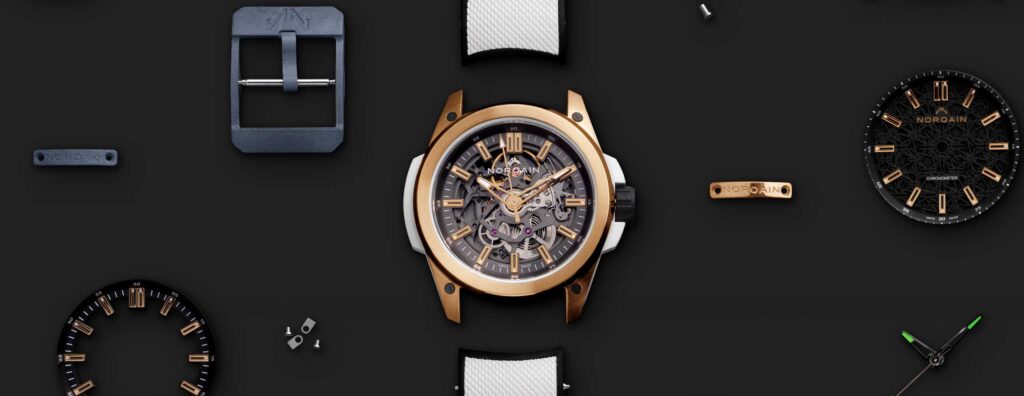Uncategorised
SIHH 2014: Vacheron Constantin Showcases The Art Of Openworked Movements
Uncategorised
SIHH 2014: Vacheron Constantin Showcases The Art Of Openworked Movements
It’s difficult to generalize about a company with as long a history and as comprehensive a range of technical capacities as Vacheron Constantin, but we can’t help feeling as if this is the year they’ve chosen to make the art of openworked watches their SIHH highlight. It’s a logical thing for them to do; Vacheron has been something of a connoisseur’s favorite in creating openworked movements for many years, and this year, they’ve created a number of new timepieces that remind us why.
Here are just a couple of the distinguished openworked Vacheron Constantin watches from years past (these are both from 2003; an openworked Malte Tourbillon and an extra thin openworked minute repeater.)
Making openworked, or skeletonized, watches isn’t easy. There are two possible approaches, each with their respective advantages and drawbacks. The first, and most classic technique, is to use a piercing file and saw to open up the bridges and plates of a movement –nowadays this traditional, manual method has largely been superseded by the use of spark erosion machines, in the interests of minimizing the risk of distorting the shape of the components. The second technique is to design a movement as an openworked calibre from the very start.
Each approach has its advantages and disadvantages. The latter allows one to design a watch that potentially can offer a much more aesthetically integrated and harmonious design –and, as it does not involve physically removing large amounts of material it’s easier to preserve the physical integrity of the movement, although at the price of higher initial manufacturing complexity. The first and more traditional method, aside from having tradition itself on its side (not a small thing, particularly in an art form as redolent of tradition as openworking) also appeals to connoisseurs for the same reason a high-wire or trapeze act sans net does: there is always a sense of impending catastrophe, which it requires skill and vigilance to avoid.
Hand-engraving cal. 4400 SQ. Everything has to be just right –perfectly sharp burin, perfect combination of pressure, direction and speed. Failure is not an option.
Vacheron Constantin has a number of offerings this year that show off the traditional art of skeletonizing. First and very spectacularly, there is an openworked version of its Patrimony Traditionelle 14-Day Tourbillon, in which calibre 2260 becomes cal. 2260 SQ (SQ here stands for “squelette” –skeletonized.) This particular movement presents a particular challenge, thanks to its architecture: the four mainspring barrels and relatively large mechanical loads involved make achieving an aesthetically satisfactory openworked version even more difficult than is ordinarily the case –especially bearing in mind that one of the criteria for success in executing a traditional openworked movement (in which a non-openworked movement is skeletonized) is achieving the maximum possible transparency without adversely affecting accuracy.
(We’re going to be comparing the non-openworked versions of these movements to the openworked versions, but bear in mind these are already top-tier movements; the comparison takes nothing away from the quality of the non-skeletonized calibers; it’s merely intended to illustrate just how much goes into doing this sort of work to a high professional standard.)
Here’s the non-openworked version of the 14 day tourbillon cal. 2260.
And here’s the openworked version and complete watch.
As you can see, Vacheron hasn’t just opened up the movement and finished the very large number of additional edges and inner corners, as well as functional surfaces, exposed by the openworking. To improve the flow of shapes through the movement, the remaining metal has been engraved with a gorgeous variety of graceful tapering curves –highly complex forms each one of which has to be both visually perfect and structurally sound. Every part of the movement, down to the outer circumference of the mainplate, has been decorated. Though we’ve mentioned it already, it’s worth repeating that openworking of this level of sophistication is extremely labor intensive; not only does the movement need to be opened up (removing a considerable amount of metal) but all the newly revealed surfaces must be finished in a visually harmonious and mechanically sound fashion; this is haute horlogerie finissage at its most unforgiving, and therefore, most exciting.
Next we’d like to show you the Malte Tourbillon Openworked. This is not the first openworked Malte Tourbillon although the movement –cal. 2790 SQ –is new for this year. It’s basically an openworked version of the shaped tourbillon cal. 2790, however 2790 SQ in addition to being openworked also offers the additional functions of power reserve indication and the date (and thus, has a slightly higher parts count.) In all other basic respects –size, power reserve, frequency –the two movements are the same.
Except, of course, they are not; here is calibre 2795.
And here’s the new openworked calibrre 2790 SQ.
And, finally, the cased-up watch.
Lastly, Vacheron Constantin has introduced a group of four new Métiers d’Art “Mécaniques Ajourées” watches –three with enameled chapter rings in black, blue, and grey grand feu enamel, and one high jewelry piece in black enamel.
These watches all use the cal. 4400 SQ, an openworked version of Vacheron’s well known cal. 4400 manual wind movement. Calibre 4400/4400 SQ is not an extra-thin movement per se but at only 2.80mm thick, it is still quite flat, and an excellent match for these slim, visually arresting and drop-dead elegant dress watches. All are offered in white gold only and the high jewelry model has 2.00 carats of baguette cut diamonds (42 in all.)
Here’s cal. 4400.
And here’s cal. 4400 SQ –and the completed watches.
We hope you’ve enjoyed this look at Vacheron Constantin’s new openworked movements for 2014, and we look forward to bringing you more in-depth coverage later this year.
Métiers d’Art Mécaniques Ajourées: a group of four 40mmx7.5mm hand-wound watches, in white gold only, featuring cal. 4400 SQ; 28.6×2.8mm running at 28,800 vph, 65 hour power reserve, openworked.. Black, blue, or grey grand feu enamel chapter rings; one high jewelry model with black enamel chapter ring and 42 baguette cut diamonds.
Malte Tourbillon Openworked (2014): featuring cal. 2790 SQ, a shaped 27.37 x 29.30 x 6.10 mm hand-wound shaped tourbillon movement, with power reserve and date; one minute tourbillon, 18,000 vph with 45 hour power reserve; openworked. Case 38 x 48.24 x 12.73 mm, platinum only.
Patrimony Traditionnelle 14-Day Tourbillon Openworked: featuring cal. 2260 SQ, 29.10 x 6.80 mm, one minute tourbillon with 14 day power reserve (336 hours) running at 18,000 vph; openworked. Case 42.00 x 12.22 mm, platinum only.
Jack Forster is the US Editor-in-Chief of REVOLUTION Magazine.
Read REVOLUTION on youriPad, Android or desktop via the Zinio newsstand app.
Follow Revolution on Facebook, Youtube, Flickr and Twitter




































